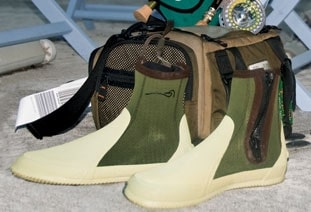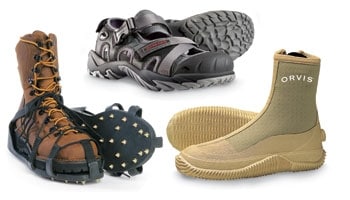
Fishing from land is one of angling’s great joys. There’s a certain intimacy that comes from having both feet planted on terra firma. Granted, tossing flies from a boat typically affords much more opportunity, but walking and fishing can often be more rewarding.
The latter creates a sense of stalking and hunting, connecting you with the environment in a very personal way and often allowing you to get closer to your quarry. Anytime I catch a fish while on foot, I feel a great sense of satisfaction, like I’ve really accomplished something significant.
Fishing from land is obviously much more common in freshwater environments, but saltwater fly-fishers traverse afoot as well. And whether you’re wading the flats, walking along beaches or stomping onto jetties, outfitting your feet properly is a very important part of the equation.
The Essentials
Of course, there’s no greater feeling than fishing barefoot, and such can be done in warm climates, usually along sandy beaches with no obstructions. But most times, saltwater anglers don’t have such luxury.
Whether in New England, Florida, the West Coast or some exotic location, coastal terrain is usually rough and tumble. Rock, coral, grating sand, assorted stinging critters and, quite often, cold water all make it necessary to protect your feet.
At its most basic level, marine footwear such as aqua socks (aka water shoes) or open-toed sandals can work for light-duty trudging in warmer climates. Just be mindful of their application.
For years, I had a pair of low-top aqua socks that I’d wear while tooling around Florida. They worked fine for the most part, but a trip to the Bahamas made fast work of them. Already somewhat worn, the massive amounts of wading we did each day – occasionally over soft, sucking bottoms – literally ripped the socks apart at the seams by the end of the trip!
Durability is generally not a problem with marine sandals, however. They offer tough construction and are commonly worn by anglers in warmer months when fishing from boats. They can be used for some wading applications, but the sole on Simms’ Pursuit sandal, for example, was designed specifically for traction and nonmarking properties on slippery boat decks.
“Interestingly enough, a nonmarking sole cannot achieve the traction of the black soles on our wading boots,” says Diane Bristol, marketing director at Simms. “It has to do with the engineering of different rubbers and the materials used to achieve the nonmarking feature.”
Sandals can certainly be used for benign hard-bottom wading, but there again, it’s important to remember that grit will invariably get inside, possibly bothering your skin.
The Tough Get Going
One solution to help keep out loose sediment is to wear high-top footwear. Several manufacturers, including Chota and Orvis, offer a popular design that features a soft neoprene body with a vertical zipper and a hard rubber sole. These type of boots are commonly used for flats wading, and when they’re properly sized, the neoprene wraps tightly around the ankles, adding enough support for trudging over mild coral bottoms.

“Of course, you still have to wear a pair of socks,” says Tom Rosenbauer, marketing director at Orvis, which makes the Christmas Island wading boot. “You’ll still get sand inside the boot. Most guys just buy a pair of white gym socks and throw them out before they come home.”
Rosenbauer makes an astute observation. Taking extra precautions always helps, and even meatier boots, such as Simms’ Flats boot or Korkers’ Ultralight boot, will benefit from your wearing socks underneath. These beefier products, meanwhile, represent the next level of durability and safety, designed with abrasion-resistant padded sides that offer excellent support and footing even when walking over extremely treacherous bottom.
But there’s treacherous, and then there’s treacherous. As everyone knows, jetties represent one of the best fish-attracting structures commonly targeted by fly-fishermen. They’re effectively fished by boat, but many anglers take on these rock outcrops via foot.
This can be downright effective – but also downright dangerous if you’re not careful, and it’s imperative to have a solid foundation at your base. Korkers addresses this with its Jetty and Jetty Plus fishing cleats. These products are essentially strap-on soles adorned with replaceable carbide spikes that can be worn over most any shoe or boot and offer solid traction on even slimy rocks and mossy concrete.
There’s nothing like walking for your fish. But as with anything else, you’ve got to prepare with the right gear, including footwear. Determine what kind of environment you’ll be traversing, and outfit accordingly. Your feet will thank you – and chances are, it’ll help with your fishing
Manufacturers
Chota Outdoor Gear
Knoxville, Tennessee
877-GO-CHOTA
www.chotaoutdoorgear.com
Korkers Products
Portland, Oregon
503-723-7100
www.korkers.com
The Orvis Co.
Sunderland, Vermont
802-362-3622
www.orvis.com
Simms Fishing Products
Bozeman, Montana
866-585-3570
www.simmsfishing.com









